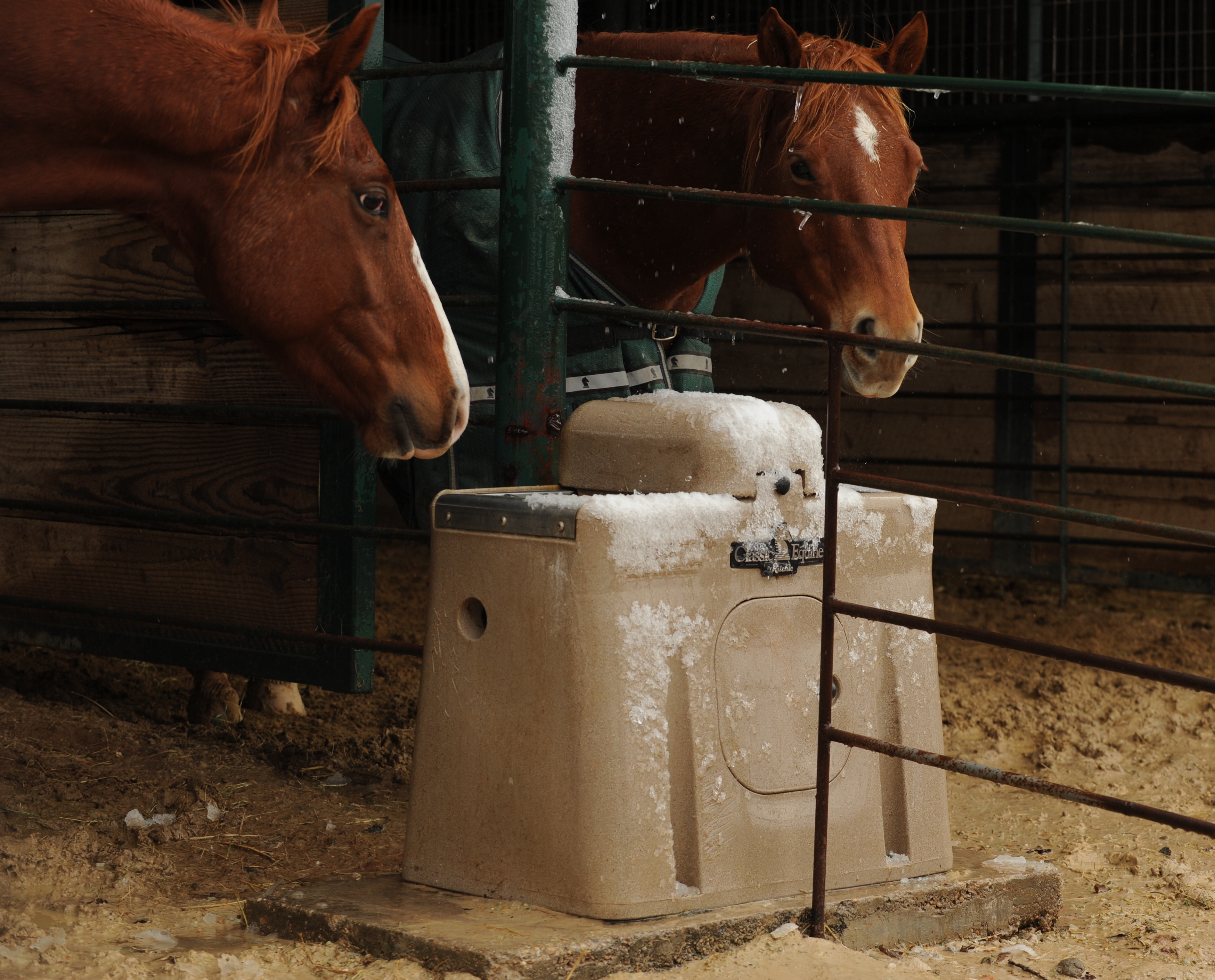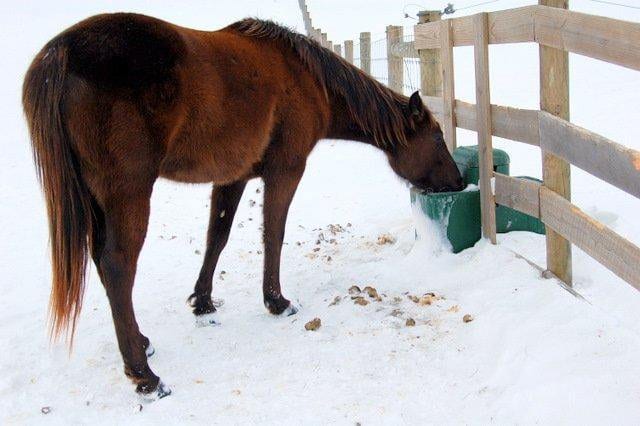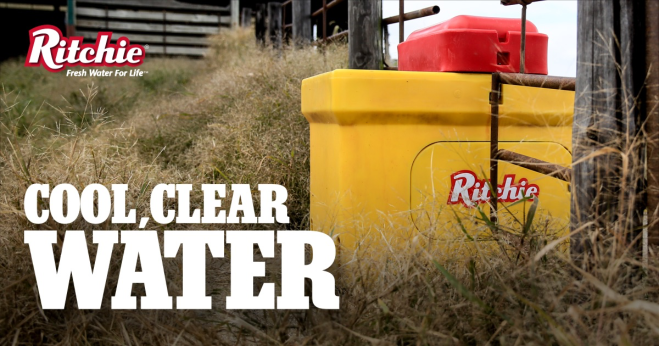As Temperatures Fall, Your Horse’s Water Needs To Rise
The crisp air mixed with a hint of wood smoke and rustling leaves along the trails signal the coming of winter. Wintertime presents challenges and changes to your horse’s nutrition, exercise, workload and water intake. One of the best management practices to ensure a healthy horse is to make sure that they drink enough water.

How Much Water?
Water consumption can be easy to overlook. During the warm seasons, horses may have access to pastures with forage that contain 60 percent to 80 percent moisture which goes toward their daily water requirements. Winter feedstuffs such as grain and hay contain less than 15 percent moisture. According to Sarah L. Ralston, DVM at Rutgers University, adult horses at rest who consume 1.5 percent of their body weight in dry feedstuffs will need a minimum of three to seven liters of water per 100 kilograms (220.5 pounds) of body weight a day. A typical 1,100-pound horse will consume four to 9 gallons. If fed only dry hay, water intake will double. Lactating mares and horses who are exercised will need to increase their water consumption by 50 percent to 200 percent.
Each horse is different but in general, mature horses at maintenance should consume between 10 to 15 gallons a day in winter. In addition to monitoring intake, you can do a simple hydration assessment on your horse.
“Feel the horse’s gums, check the capillary refill time (CRT) by pushing a finger against their gums and counting how long it takes for the tissue to go from a pale white color to its normal pink color, and pull their skin away from the body to judge how quickly it ‘snaps’ back into place,” said Laura Petroski-Rose, BMV&S and Kentucky Equine Research staff veterinarian. “Normal parameters for these checks would be moist gums (not dry or tacky), CRT should be less than two seconds, and the skin should snap back into place immediately – about one second.”
Increased Water Intake Helps Decrease Chance of Impaction Colic
Anyone who has gone through the pain and expense of impaction colic or any form of colic knows that an ounce of prevention is worth a pound of cure. Colic is still the No. 1 killer of horses and increasing water intake is still one of the recommended ways to reduce the risk. A horse who is not drinking enough water can begin to experience dehydration and impaction colic in as few as 48 hours.
Hay quality also impacts the risk of colic. In general, stalky hay sometimes called cattle hay is less digestible than leafy varieties. Cattle’s ability to digest stalky grass falls off only 2 or 3 percent compared to leafy grass. Horses on the other hand, experience a 20 percent or more drop off. Horses have a digestive tract that is about 100 feet long and has adapted to a diet of grazing small amounts of grass nearly continuously. This comes into conflict with modern-day management practices and all dietary changes should be monitored for gastrointestinal upsets.
The physical form of the hay also affects water intake. In a digestibility study conducted by Kentucky Equine Research, horses fed alfalfa hay in a long-stem form had significantly wetter feces (81.5 percent versus 75.2 percent) than when an identical amount of the same forage was fed in a pelleted form.
“You always want to feed high quality hay (whether it be alfalfa or grass hay) as this is the best source of protein and nutrients for your horse while also being easier for the gastrointestinal tract to digest.,” said Petroski-Rose. “Low quality hay tends to have thick and tough stems, which the gut is much less efficient at breaking down. Regarding feeding pellets, we are faced with both benefits and disadvantages. The most rewarding times to feed pellets would be in horses with dental or respiratory issues, as these can control some of the factors that exacerbate those diseases. Pellets, however, have been shown to dehydrate the fecal matter in comparison to hay. A way around this could be to soak the pellets in water, which I generally recommend as fast, greedy eaters can experience choke. Additionally, encouraging your horse to consume more water is ideal and having fresh, clean water sources available at all times is imperative.”

Tips on How to Get Your Horse to Drink More Water
Turn Up the Heat
During the winter horses have a natural tendency to drink less water in colder temperatures so you need to be diligent with providing fresh, clean water at the right temperature.
Researchers at the University of Pennsylvania School of Veterinary Medicine found during cold weather that horses drank almost 40 percent more water per day if they were given warm (45 F to 65 F) water instead of ice cold water. Interestingly, when horses were given a choice between warm and ice water at the same time, they almost exclusively chose the ice water and drank less volume. Keep your water warm and your horse will drink more, it’s that simple.
Use Electrolytes and Supplements
According to Lydia Gray, DVM and staff veterinarian at SmartPak, top dressing your horse’s feed with electrolytes and offering loose salt will help encourage more water consumption. A note of caution about electrolytes, without adequate water consumption further dehydration can occur. Adult horses need 1 to 2 ounces of salt daily. Loose salt is preferred over frozen salt blocks during the winter.
Keep Your Water Clean
Life gets hectic and sometimes cleaning out troughs or buckets is low on the list of priorities, but it is a necessary chore. Small bits of hay, feed or even manure in a bucket or trough is not appealing to any horse. Troughs are notorious for algae growth and leaf/debris decomposition making the water taste bad. Automatic waterers reduce this chore significantly, but they will still need regular cleaning.
Underlying Health Issues Can Impact Water Consumption
The most common issue is diarrhea. Monitoring manure will give you a heads up on how much water is being lost. On the flip side, horses who have drier or less manure production are telling you that they are not drinking enough, and an intestinal blockage or impaction may occur.
Horses with Cushing’s or chronic kidney disease will drink more water than typical.
Don’t forget about the condition of your horse’s teeth. Diseased or sensitive teeth may lead to pain when drinking cold water which in turn leads to your horse avoiding the waterer – offer warm water to entice them.
Easy Solutions for Every Horse Owner This Winter
The easiest and hassle-free option to consider is an automatic waterer. Top of the line waterers feature rugged, insulated polyethylene or stainless-steel units with designs that seal cold air away from the high capacity valves. Options such as thermostatically controlled heat, self-regulated heaters, immersion heaters and digital water meters are typically available.
The best-selling automatic waterers are made by Ritchie Industries, Inc., the company that invented automatic waterers in 1921. The Classic Equine by Ritchie waterers are specifically engineered to meet the rigorous standards that horse owners demand.
“There’s nothing worse than breaking ice or doing maintenance on a waterer when it is freezing outside,” said Tyler Yantis, sales manager at Ritchie Industries, Inc. “The Classic Equine by Ritchie products offer a durable, quality fount that is energy efficient and eliminates the hassle of most common maintenance chores. We have individual stall mount models, portable models and models designed for up to 40 head of horses. We offer digital water meter options on every model to monitor intake because we know how important water is to overall horse health. We have a winter watering solution for every horse farm and every budget. Your horse deserves fresh, clean, temperature-controlled water on demand.”
For more information on Ritchie waterers, visit classicequinebyritchie.com.
The other route to go is to clean and fill buckets several times a day. This can be labor intensive and still would require bucket heaters in cold climates. Larger stock tanks made from structural foam with optional heaters are also another option. Many horse owners avoid floating heaters without guards, especially if they have a rascal in the herd. Playful horses have a knack for tossing the floating heaters out of the tank, leaving you with a large ice block.
Before using any de-icer/heater, make sure to inspect it carefully for worn wires or other damage, and be sure it is working properly. Safety is paramount – the last thing you want is for the horse to experience a mild shock that will scare them away from the water.
Conclusion
Good wintertime horse management means providing your horse with an ample supply of fresh, clean water at all times. Remember horses will not break ice to drink. It is best practice to provide water at a temperature between 45 F and 65 F to encourage adequate water consumption. Monitor water consumption to reduce the risk of impaction colic and if any problems arise, consult your veterinarian.

